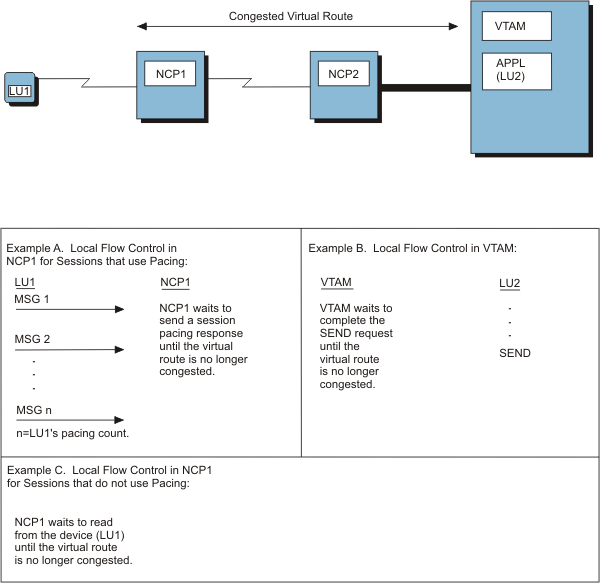 z/OS Communications Server: SNA Network Implementation Guide
z/OS Communications Server: SNA Network Implementation Guide
 z/OS Communications Server: SNA Network Implementation Guide
z/OS Communications Server: SNA Network Implementation Guide
|
Previous topic |
Next topic |
Contents |
Contact z/OS |
Library |
PDF
Local flow control and severe congestion z/OS Communications Server: SNA Network Implementation Guide SC27-3672-01 |
|
|
Virtual route pacing is supplemented by a local flow
control function that limits the amount of data that users within
a subarea can present to the network for transmission. Figure 1 illustrates local flow control.
Figure 1. Local flow control
 Suppose, for example, that the virtual route between NCP1 and VTAM® is congested and that VTAM has been notified of the congestion. If NCP1 does not give VTAM permission to send another window of data, the virtual route is held. VTAM then keeps the windows of data in IOBUF buffer space until the data can be passed. If LU1 is an SNA device and session pacing is being used on the LU-LU session, NCP1 withholds the session pacing response going to LU1 until the virtual route is no longer congested. (See Example A in Figure 1.) Because virtual route pacing controls only normal-flow requests, LU1 can still send responses to previously received requests and expedited flow requests. Because those RUs can also congest the virtual route, NCP1 holds them until the congestion clears. If LU1 is a non-SNA device (or an SNA device that is not using session pacing on the LU-LU session), NCP1 does not read any input from the device until the virtual route is no longer congested. (See Example C in Figure 1.) When the application program (LU2) in Host1 sends data to a device
attached to NCP1, VTAM holds
the data in IOBUF buffer pool space until it is informed that the
virtual route is no longer congested. After the virtual route is blocked
and VTAM holds the windows
of data, VTAM queues the application
program SEND request and does not read the data from the user buffer.
(See Example B in Figure 1.) The direction
of data flow is paced independently. One direction might be congested
while the other direction is not. Figure 1 shows a virtual route that is congested in both directions.
Note: If VTAM determines that sessions
with one of its local devices are contributing to congestion over
a route, it shuts off data transmission from the device. Therefore, if
there are a number of SNA devices attached to a channel-attached cluster
controller, sessions for all the devices are shut down, regardless
of whether their sessions are being conducted over the congested route
or another route. To avoid this, you might want to specify inbound
session pacing for all channel-attached SNA devices so that they are
each paced separately. See Session-level pacing.



|
 Copyright IBM Corporation 1990, 2014 Copyright IBM Corporation 1990, 2014 |